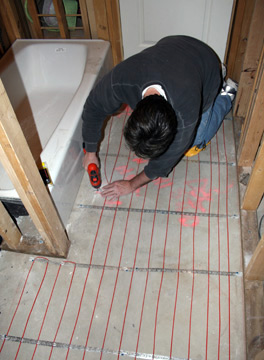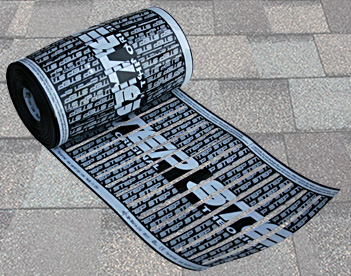Low-voltage vs. Line-voltage
There has been much debate over low voltage radiant systems versus line voltage radiant systems as radiant heat gains popularity in North America. The aim of this article is to dispel some of the myths surrounding the different kinds of systems. Warmzone offers both low-voltage and line-voltage systems. Both can provide excellent results for floor heating and snow melting applications.
Myth 1: Low voltage radiant systems are safer than line voltage.
Low voltage is low, so it makes sense that it’s safer, right? While this makes perfect sense initially, we have to take a closer look to find out the real answer. If your definition of safe is the chances of being hurt by voltage during installation, low voltage will give you a bit of a shock, but won’t cause lasting damage. The real question we should be asking is how durable is the cable against damage and how well is the cable insulated. Both line- and low-voltage snow melting systems are embedded in 4 inches of concrete, asphalt, or under pavers. When installed properly the embedded systems are not exposed and harmful. Some low-voltage heating wires are NOT designed to be embedded. These have only a thin layer of plastic and a heating element that is THHN/THWN wire. This wire is intended for interior use NOT in concrete, asphalt, or under pavers. Low voltage wires do not have ground fault protection, so electrical leakage can go undetected.
In contrast, line voltage obviously has higher voltage, which is why line voltage cables are built to withstand wear and tear, and are much more difficult to damage. If you do manage to damage a line voltage cable, don’t worry! Line voltage systems are equipped with ground fault protection (GFEP) breakers with a 30 milliamp trip. Which means the system will automatically shut off when it has reached beyond allowable leakage levels. What does this mean? Well for one you don’t need to worry about bodily harm, but you also don’t need to worry about potential fire hazard from a damaged cable. The bottom line: both line voltage and low voltage systems are safe to use.
Myth 2: Low voltage radiant systems cost less to run than a line voltage system.
It is true that low voltage radiant systems consume a lower amount of power, but this doesn’t mean it is less costly to run. Low voltage systems can actually be more expensive to operate because these systems generally produce 20 watts/sq ft (which is below ASHRAE standards). By producing less heat per square foot, it takes longer to heat the same area, thus increasing the cost and the time it takes to melt. Because of the decreased heat output, during heavier snow falls low voltage systems struggle to keep up with the snowfall, and have to remain on much longer. For this reason, ASHRAE has set forth watt standards for snow melting.
Line voltage systems are designed specifically for the environment in which they will be operating. These systems are made to produce the necessary watts (that meet ASHRAE standards) to melt snow in the most efficient time possible.

Some low voltage systems on the market have some distinct advantages over line voltage. RoofHeat STEP and FloorHeat STEP are low voltage, but does not rely on heat cables to generate heat. Instead it is constructed of a unique polymer heating element that requires no embedding in thinset and can be installed directly under carpet pad, hardwood and even for use on your roof for snow and ice melting. The biggest advantage of RoofHeat STEP is that you can hammer nails into it without worry of damage!
Myth 3: Low voltage systems are easier to repair.
Both line voltage and low voltage cables are easy to repair. Simply remove the bad section of cable, add in a splice kit, cover it back over with whatever surface it’s in, and the system should operate as normal. You do not have to replace the entire cable or rip out the entire surface, only the area that is damaged. The location of the break can be identified by using devices such as the DEVItrace from Danfoss or a TDR, which uses radio frequencies and a “wand” to locate the damaged section of cable.
Myth 4: Low Voltage systems are more efficient.
While Warmzone carries both low-voltage and line-voltage systems, low voltage systems are NOT necessarily more efficient. Since these systems have a much lower output of heat per square foot; they can take longer to melt snow, especially during heavy snow storms and probably will not be able to keep up with the demand. Further increasing their inefficiencies, most low voltage systems must have the electricity pass through a transformer and very thick power leads (2 gauge), which causes voltage to drop as it travels distance before reaching the heating element. Line voltage cables have the energy to go directly into heating, without the loss of power. Overall, both line and low voltage systems are more efficient than hydronic snow melting.
Myth 5: Low voltage systems offer a better warranty.
Some low voltage warranties are very deceiving. They boast of a 25 year warranty period, but when examined closer it is found that the 25 year warranty only covers the heating wire. As discussed earlier these heating wires are actually THHN or THWN, which can be purchased relatively cheaply at any hardware store. The ideal low-voltage system features a flexible polymer heating element, such as RoofHeat STEP.

Warmzone also backs up its line voltage cable with one of the best manufacturer warranty in the business.
Myth 6: Both systems provide sufficient heat.
Low voltage systems in most snow melting applications do not meet the ASHRAE standards. The minimum watts per square foot ASHRAE requires in North America is 32 watts per square foot. Popular low voltage systems on average are designed to produce approximately 20 watts per square foot and with extremely tight spacing will max out at 30, still below the standards ASHRAE has set forth.
Line voltage systems are designed specifically for the environment in which they will be operating. These systems are made to produce the necessary watts (that meet ASHRAE standards) to melt snow in the most efficient time possible.
Myth 7: Both systems are UL Approved.
Most low voltage snow melting systems are not UL listed. Warmzone’s line voltage systems are UL tested and approved.
SYSTEM WEAKNESSES
- THHN/THWN wire was not designed for concrete embedding. The outer jacket is soft and easily cut which will shorten its life.
- Low heat output – Does not satisfy ASHRAE requirements.
- Bulky and costly controls (transformer and control box are 100 lbs per 200 square foot zone).
- Warranty – only covers THHN/THWN wire. Control box is 1 year, transformer is 5 years.
- Slow to install – the transformer and control box are complicated and time consuming to install.
- Noise – transformers emit noise and location of them must be considered.
- Price – low-voltage systems are typically double the price of a comparable line–voltage system.
As radiant heating systems have gained popularity, a lot of fly-by-night manufacturers are trying to cash in on the recent boom. This sparked ASHRAE to come out with standards for radiant snow melting systems to prevent abuse from manufacturers. Most low voltage radiant snow melting systems don’t meet the ASHRAE standards for quality and efficiency. Unfortunately, not all consumers are aware of standards in the radiant industry and purchase faulty products unwittingly and end up with negativity towards radiant heating in general. Rest assured there are plenty of efficient radiant systems that will run smoothly for decades without needing any maintenance. Make sure to do thorough research before purchasing any products, which means checking for proper safety certifications and standards, and you won’t regret it.
NOTE: IN 2012, WARMZONE UPGRADED TO THE ADVANCED LOW-VOLTAGE SYSTEM, FEATURING A FLEXIBLE POLYMER HEATING ELEMENT, WHICH IS SAFER, EASIER TO INSTALL, AND MORE EFFICIENT THAN PREVIOUS LOW-VOLTAGE SYSTEMS.
